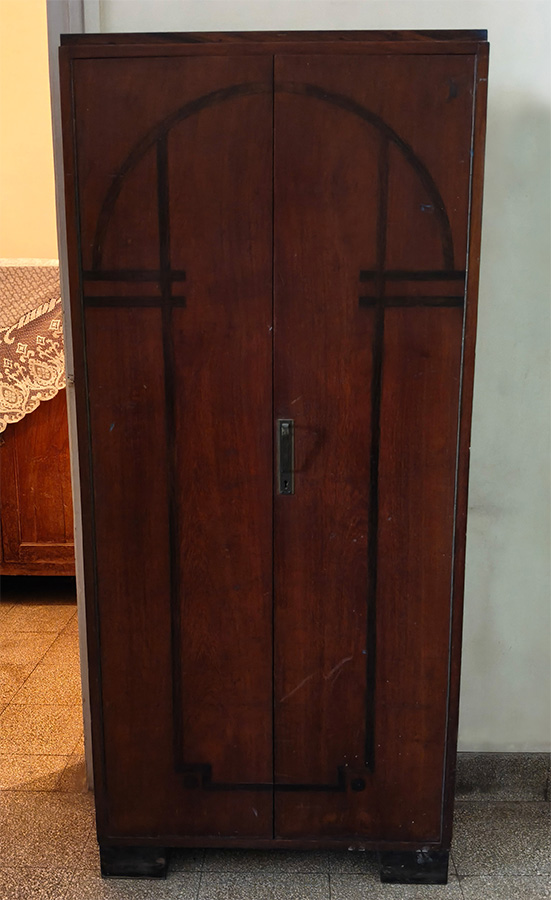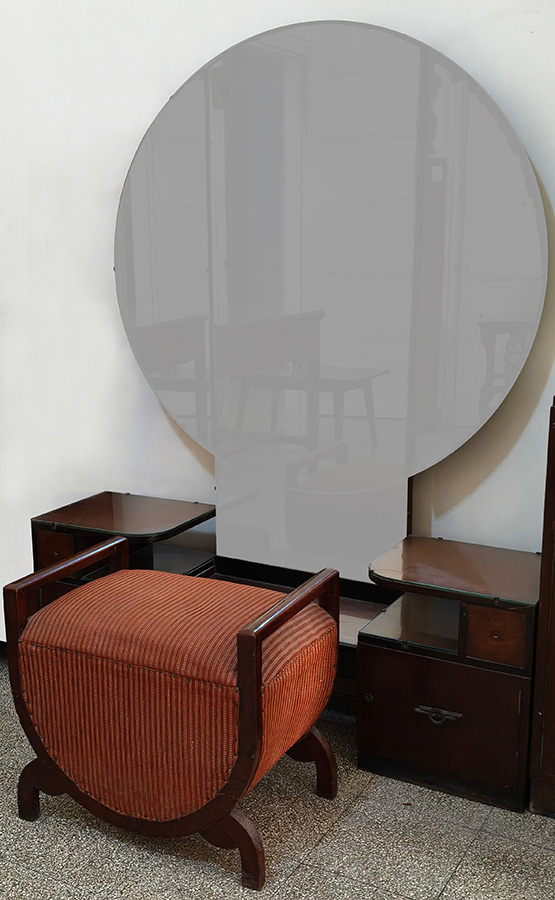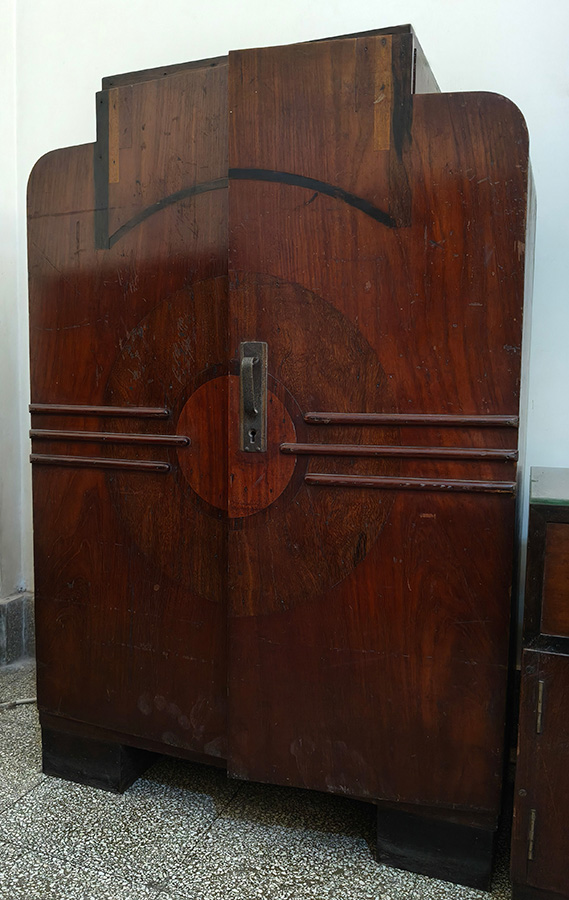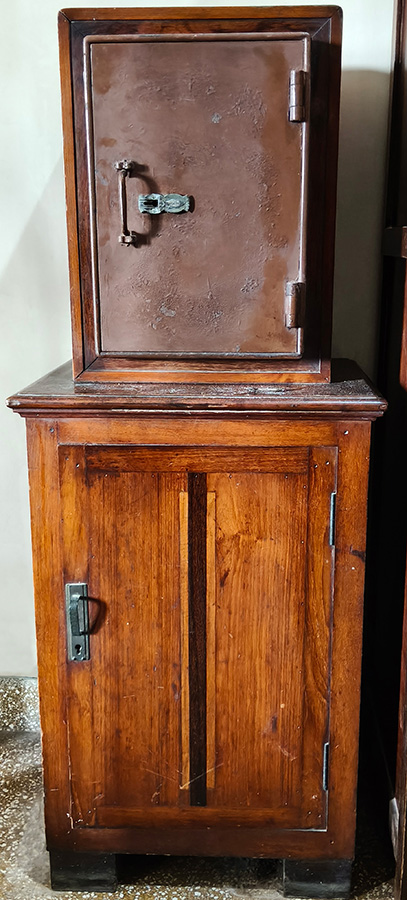The next chapter in the multi-part auction series of The Estate of Sir Mangaldas Nathubhai turns to the interiors of 1930s Bombay — a city at the height of its Art Deco transformation. As cinemas, apartment blocks, and seafront promenades rose along Marine Drive and Colaba, this new design language entered Bombay’s homes. Within the Mangaldas family residences at Girgaum, Malabar Hill, and later Commonwealth, these cabinets, wardrobes, and vanities reflected the same spirit of progress, precision, and elegance that defined the era.
A Modern Legacy
Art Deco furniture in Bombay combined international design ideals with Indian craftsmanship — streamlined silhouettes, sunburst veneers, stepped profiles, and richly figured hardwoods. For the Nathubhai family, these were not just expressions of style but part of a lived modernism, objects used and remembered across generations.
As Mita Sujan, Sir Mangaldas’s great-great-granddaughter, recalls:
“The small safe has been used for generations — to store daily household money and jewelry. The dressing tables too — my daughters wouldn’t let me sell them because they remember Ma sitting there to put on her bindi and jewelry before a party. The cupboards once held my grandmother’s white saris and later were used by my children and grandson.”
These recollections root the collection in domestic memory — furniture that witnessed the quiet rhythms of family life while embodying the glamour of Bombay’s modern age.
Design and Detail: Highlights from the Collection
Form and Geometry
The Striking Art Deco Hardwood Cabinet captures the era’s architectural sensibility. Its bold, arched doors and layered horizontal banding form a graphic composition of light and shadow. The structure stands on a stepped plinth — a clear nod to Streamline Moderne design — and opens to reveal practical shelving. Compact and imposing in equal measure, it reflects how 1930s design could balance strength with restraint.

Equally thoughtful in scale is the Compact Art Deco Cabinet (Lot 14), whose minimalist block form and soft symmetry make it ideal as a bedside or ancillary unit. Its faint arched motif and low plinth base speak to the subtle elegance that distinguished Indian interpretations of Deco.
Glamour and Reflection
The Complete Art Deco Three-Piece Vanity Set with Circular Mirror and Stool is one of the most striking ensembles in the auction. Defined by a monumental circular mirror rising from an asymmetrical console base, it combines two curved pedestals of differing heights linked by a polished glass top. The original stool — with its curved sled base — completes the set, preserving the sculptural fluidity that defined 1930s interiors.

Complete Art Deco Three-Piece Vanity Set with Circular Mirror and Stool
Its companion, the Asymmetrical Vanity Desk and Stool Ensemble (Lot 20), continues this language of motion and balance. Crafted in dark hardwood with continuous curves and clean surfaces, it reveals the Bombay craftsman’s understanding of form as both functional and expressive.
Architecture in Wood
A rare highlight is the High-Style Compactum Cabinet with Stepped “Skyscraper” Silhouette. The stepped cornice and rounded corners echo the vertical ambitions of early modern architecture — a furniture-scale interpretation of the city’s own skyline. Its circular veneer motifs and contrasting banding celebrate the Machine Age fascination with precision and order.

High-Style Compactum Cabinet with Stepped “Skyscraper” Silhouette
The Monumental Two-Part Cabinet with Veneer Sunburst (Lot 21) pushes that architectural impulse further. Composed of two stacked sections, its façade radiates with concentric circles and arched motifs in contrasting veneers. Commanding yet refined, it reflects the Deco belief that modern craftsmanship could achieve both grandeur and grace.

Monumental Two-Part Cabinet with Veneer Sunburst
The Combination Wardrobe with Geometric Paneling and Curved Frieze offers a more restrained approach — tall, clean-lined, and versatile. Its subtle half-moon arch motif softens its structure, suggesting a functional simplicity that defined mid-century living spaces.
Compact Elegance
The Compact Storage Cabinet and the Tall Linen Press demonstrate how Deco principles translated into everyday design. The former, with its concentric veneer circles and stepped cornice, likely served as a cocktail cabinet or dry bar. The latter, in lighter hardwood with dark horizontal banding, projects a sense of poised monumentality — modernism adapted for the home.
Security and Memory

Rare Art Deco Hardwood Cabinet with Integrated Strongbox
Closing the Art Deco series is the Rare Hardwood Cabinet with Integrated Strongbox (Lot 28), an object that fuses design with practicality. The lower portion functions as a classic Art Deco cabinet, while the upper houses an industrial metal safe — a tangible link between domestic life and Bombay’s mercantile modernity.
“The small safe has been used for generations,” recalls Mita Sujan. “It held everyday jewelry and household cash.”
This hybrid piece captures exactly what makes the Nathubhai collection extraordinary: the meeting of beauty, function, and memory.
Art Deco and Bombay’s Modern Imagination
From grand theatres to dressing tables, Bombay’s Art Deco movement was a declaration of modern life — optimistic, cosmopolitan, and confident in craftsmanship. The pieces in this auction embody that sensibility, uniting architectural precision with personal intimacy.
Preserved for decades and now offered for the first time, they represent not only an era of design but also the family who lived within it.